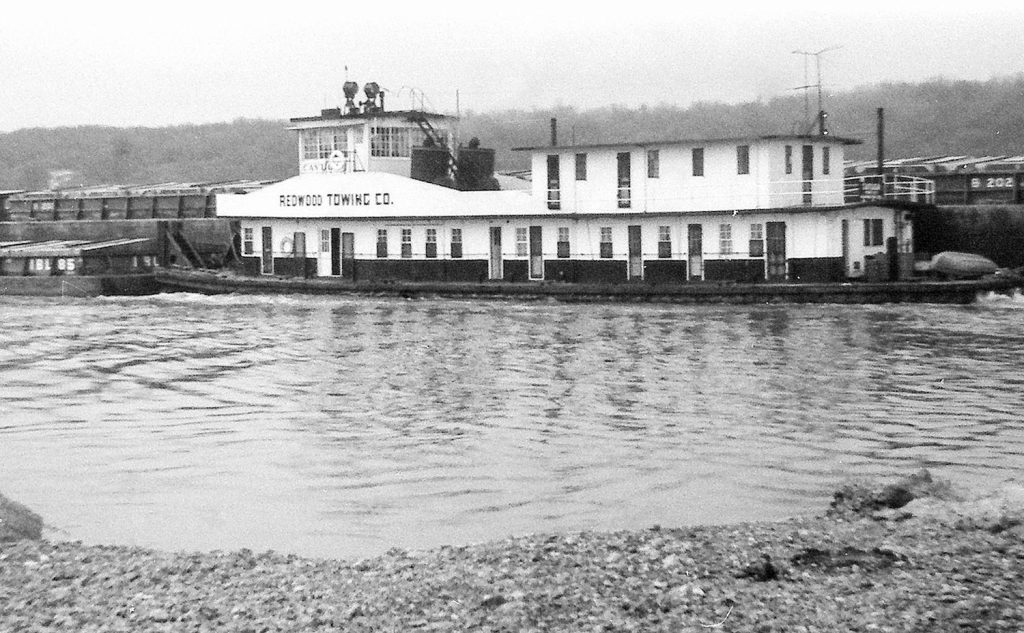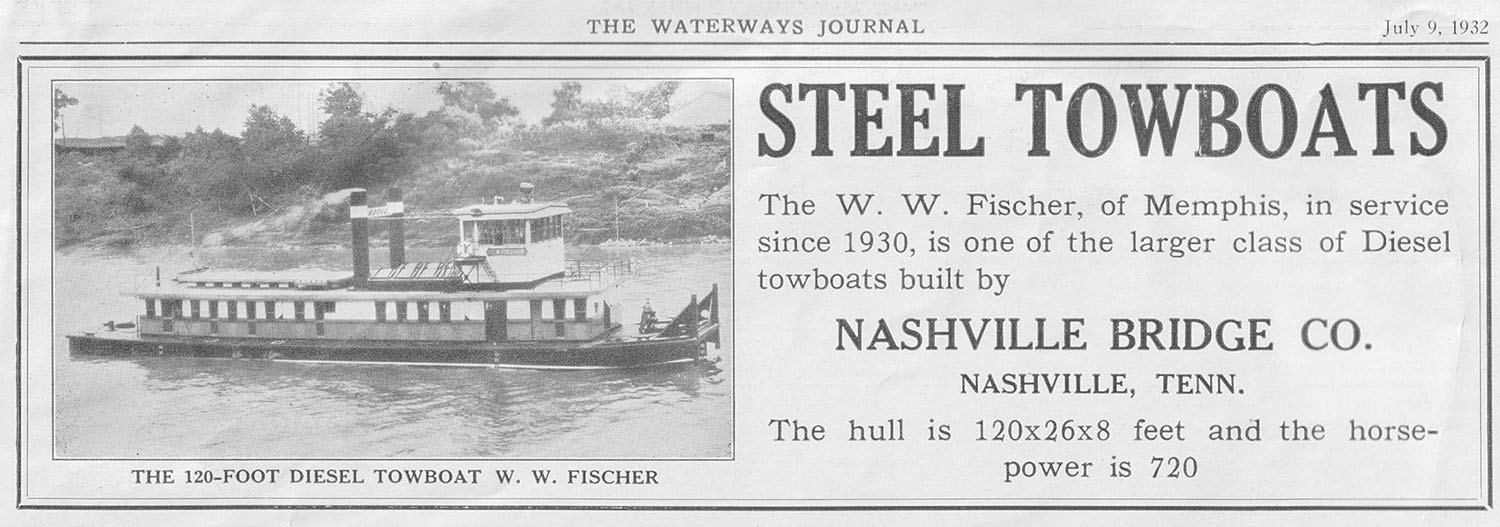As the true age of diesel towboats was dawning in the late 1920s, just a few shipyards were building larger towboats of that type. Charles Ward Engineering Works at Charleston, W.Va., was an early proponent of the twin-screw diesel line-haul boats, as evidenced by the Geo. T. Price of 1925 and the W.A. Shepard of 1927, both built for the W.C. Kelly Barge Line. Nashville Bridge Company, Nashville, Tenn., had also become known for its diesel craft, and in 1929 turned out one that was very similar to the two successful Ward boats.
The boat was built for Central Sand & Gravel Company of Memphis, Tenn. It had a steel hull with dimensions of 120 by 26 feet and was powered by a pair of direct-reversing Fairbanks-Morse engines with a total of 720 hp. There was a single cabin and a slightly elevated pilothouse, outfitted with multi-paned window sash above that. Large skylight vents over the engineroom were behind the pilothouse, followed by two high steamboat-style smokestacks. The rest of the roof had a traditional cabin skylight over it.
The new vessel was christened W.W. Fischer and became a familiar sight in the Memphis area. A photo of it was often seen in issues of The Waterways Journal through the early 1930s in ads for Fairbanks-Morse and Nashville Bridge. The Memphis News columns of the WJ also made mention of the Fischer, reporting in the February 20, 1932, issue that “The Central Sand & Gravel Company’s towboat W.W. Fischer, Capt. Charles Warner, master, is busy these days pushing gravel from the digger located at the head of President’s Island, along with other work. Jesse Nelson is chief engineer on the Fischer.” In the May 21, 1932, issue, the boat was “busy in the lower harbor,” and it had Capt. Kyle Templeton as master with Fred Nelson as chief engineer.
In 1935, the Fischer was sold to the Kosmos Towing Company of Louisville.
Kosmos had been a customer of Nashville Bridge since that firm had built its first boat, the 180 hp. single-screw Kosmos. In 1926, Nashville built the twin-screw, 240 hp. towboats Kings Landing and Kosmortar (WJ, May 22, 2023) for the Kosmos fleet, followed by the 150 hp. Kenton in 1929. It was no surprise that Kosmos would add an existing Nashville-built boat to its stable, nor was it a surprise when the company followed its longstanding tradition of names beginning with “K” to rename the boat Kormorant.
The Kormorant was the largest, most powerful boat that Kosmos owned at the time, and according to a history of the company by David Baker, Capt. Ollie W. Nowlin was named master of the boat. During the disastrous 1937 flood, the Kormorant was much involved in rescue and relief work, first at Louisville, delivering some stranded citizens, including many from the company town of Kosmosdale, Ky., down to higher-situated Brandenburg, Ky. It later worked at Evansville, Ind., delivering some 10,000 sandbags and assorted equipment to the local waterworks.
At some point, Kosmos built a second deck cabin on the boat aft of the stacks, eliminating the skylight. In 1950, Kosmos repowered the Kormorant with a pair of EMD 12-567 engines totaling 1,800 hp. During this repowering, the tall stacks and large engineroom skylight vents were removed, replaced by a lower, more streamlined pair of stacks. It would retain this appearance, with few changes, for the remaining years it ran.
In 1956, the Kormorant was sold, and the ownership trail gets interesting. The Inland River Record shows the new owner as Aiple Towing Company, Stillwater, Minn., while the List of Merchant Vessels would give the owner as a Delaware corporation called North Central Barge Line. In any case, the name was changed to Cayuga, and in 1957 there was either a repowering or an upgrade to the existing engines, then giving the boat 2,400 hp. The IRR indicates an ownership change in 1972 to Minnesota Harbor Service, but in 1977 the owner was again shown as Aiple.

The Cayuga was operated by different companies over several waterways throughout this period, and one photo purportedly taken on the Illinois River shows it with “Redwood Towing Company” on the side of a bulwark that had been added to the second deck.
In February 1974, a 19-year-old from the Louisville area was talking with a family acquaintance who mentioned that he had gone back to work on the river. The young man indicated that he might like to also do that. Three days later he traveled to Greenville, Miss., where he caught the upbound Cayuga as a green deckhand. Today he is well-known marine insurance broker Michael Ash, of the Ash Group.
Ash vividly recalls his time aboard the Cayuga. (His first “hitch” lasted 52 days.) He remembers the multitude of windowpanes in the mostly wooden pilothouse with a tar paper roof, the steam heat with cast-iron radiators in each room, the lack of any air conditioning on sweltering summer days and a claw-foot bathtub in the second-deck cabin. The cable steering was so stiff that he said three pilots boarded and then quit in a single week. A cable breaking on the same system and some other untimely breakdowns led to some exciting (and scary) incidents.
Ash went on to work on deck for other companies such as TPT and Canal before ultimately joining the claims department of ACBL and later starting his own firm. Undoubtedly his Cayuga experience gave him a great background toward understanding some future marine happenings he would help to resolve.
The Cayuga was listed through the 1988-1989 edition of the IRR, finally appearing in the Off The Record section of the 1990 edition with the notation that it had been converted into a landing boat. This early, pioneering diesel prop towboat had a productive operating career of some 60 years, then evidently continued to be useful for some years after as a landing boat.
Caption for top photo: The new W.W. Fischer in a July 9, 1932, Waterways Journal ad. (David Smith collection)
Capt. David Smith can be contacted at davidsmith1955obc@gmail.com.




